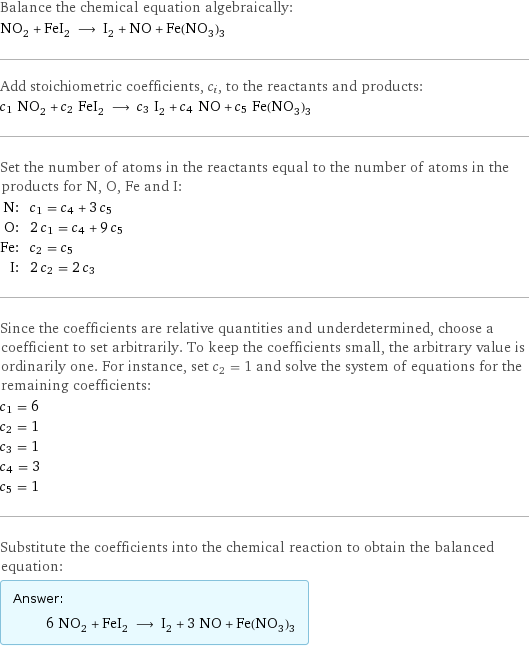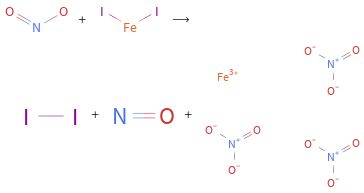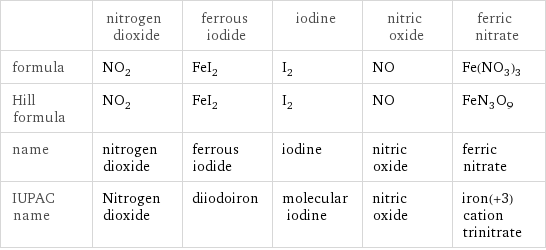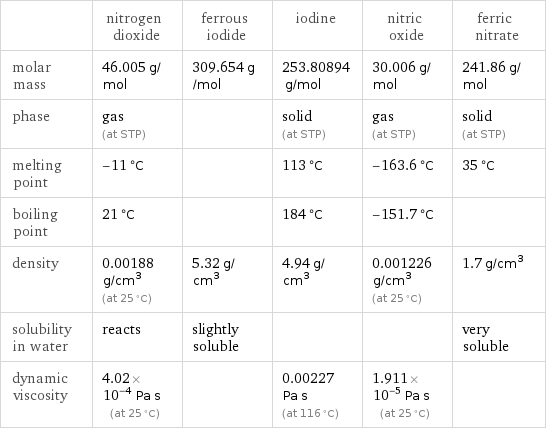Input interpretation

NO_2 nitrogen dioxide + FeI_2 ferrous iodide ⟶ I_2 iodine + NO nitric oxide + Fe(NO_3)_3 ferric nitrate
Balanced equation

Balance the chemical equation algebraically: NO_2 + FeI_2 ⟶ I_2 + NO + Fe(NO_3)_3 Add stoichiometric coefficients, c_i, to the reactants and products: c_1 NO_2 + c_2 FeI_2 ⟶ c_3 I_2 + c_4 NO + c_5 Fe(NO_3)_3 Set the number of atoms in the reactants equal to the number of atoms in the products for N, O, Fe and I: N: | c_1 = c_4 + 3 c_5 O: | 2 c_1 = c_4 + 9 c_5 Fe: | c_2 = c_5 I: | 2 c_2 = 2 c_3 Since the coefficients are relative quantities and underdetermined, choose a coefficient to set arbitrarily. To keep the coefficients small, the arbitrary value is ordinarily one. For instance, set c_2 = 1 and solve the system of equations for the remaining coefficients: c_1 = 6 c_2 = 1 c_3 = 1 c_4 = 3 c_5 = 1 Substitute the coefficients into the chemical reaction to obtain the balanced equation: Answer: | | 6 NO_2 + FeI_2 ⟶ I_2 + 3 NO + Fe(NO_3)_3
Structures

+ ⟶ + +
Names

nitrogen dioxide + ferrous iodide ⟶ iodine + nitric oxide + ferric nitrate
Equilibrium constant
![Construct the equilibrium constant, K, expression for: NO_2 + FeI_2 ⟶ I_2 + NO + Fe(NO_3)_3 Plan: • Balance the chemical equation. • Determine the stoichiometric numbers. • Assemble the activity expression for each chemical species. • Use the activity expressions to build the equilibrium constant expression. Write the balanced chemical equation: 6 NO_2 + FeI_2 ⟶ I_2 + 3 NO + Fe(NO_3)_3 Assign stoichiometric numbers, ν_i, using the stoichiometric coefficients, c_i, from the balanced chemical equation in the following manner: ν_i = -c_i for reactants and ν_i = c_i for products: chemical species | c_i | ν_i NO_2 | 6 | -6 FeI_2 | 1 | -1 I_2 | 1 | 1 NO | 3 | 3 Fe(NO_3)_3 | 1 | 1 Assemble the activity expressions accounting for the state of matter and ν_i: chemical species | c_i | ν_i | activity expression NO_2 | 6 | -6 | ([NO2])^(-6) FeI_2 | 1 | -1 | ([FeI2])^(-1) I_2 | 1 | 1 | [I2] NO | 3 | 3 | ([NO])^3 Fe(NO_3)_3 | 1 | 1 | [Fe(NO3)3] The equilibrium constant symbol in the concentration basis is: K_c Mulitply the activity expressions to arrive at the K_c expression: Answer: | | K_c = ([NO2])^(-6) ([FeI2])^(-1) [I2] ([NO])^3 [Fe(NO3)3] = ([I2] ([NO])^3 [Fe(NO3)3])/(([NO2])^6 [FeI2])](../image_source/547d6f39f4aa695ea96cd441108a8675.png)
Construct the equilibrium constant, K, expression for: NO_2 + FeI_2 ⟶ I_2 + NO + Fe(NO_3)_3 Plan: • Balance the chemical equation. • Determine the stoichiometric numbers. • Assemble the activity expression for each chemical species. • Use the activity expressions to build the equilibrium constant expression. Write the balanced chemical equation: 6 NO_2 + FeI_2 ⟶ I_2 + 3 NO + Fe(NO_3)_3 Assign stoichiometric numbers, ν_i, using the stoichiometric coefficients, c_i, from the balanced chemical equation in the following manner: ν_i = -c_i for reactants and ν_i = c_i for products: chemical species | c_i | ν_i NO_2 | 6 | -6 FeI_2 | 1 | -1 I_2 | 1 | 1 NO | 3 | 3 Fe(NO_3)_3 | 1 | 1 Assemble the activity expressions accounting for the state of matter and ν_i: chemical species | c_i | ν_i | activity expression NO_2 | 6 | -6 | ([NO2])^(-6) FeI_2 | 1 | -1 | ([FeI2])^(-1) I_2 | 1 | 1 | [I2] NO | 3 | 3 | ([NO])^3 Fe(NO_3)_3 | 1 | 1 | [Fe(NO3)3] The equilibrium constant symbol in the concentration basis is: K_c Mulitply the activity expressions to arrive at the K_c expression: Answer: | | K_c = ([NO2])^(-6) ([FeI2])^(-1) [I2] ([NO])^3 [Fe(NO3)3] = ([I2] ([NO])^3 [Fe(NO3)3])/(([NO2])^6 [FeI2])
Rate of reaction
![Construct the rate of reaction expression for: NO_2 + FeI_2 ⟶ I_2 + NO + Fe(NO_3)_3 Plan: • Balance the chemical equation. • Determine the stoichiometric numbers. • Assemble the rate term for each chemical species. • Write the rate of reaction expression. Write the balanced chemical equation: 6 NO_2 + FeI_2 ⟶ I_2 + 3 NO + Fe(NO_3)_3 Assign stoichiometric numbers, ν_i, using the stoichiometric coefficients, c_i, from the balanced chemical equation in the following manner: ν_i = -c_i for reactants and ν_i = c_i for products: chemical species | c_i | ν_i NO_2 | 6 | -6 FeI_2 | 1 | -1 I_2 | 1 | 1 NO | 3 | 3 Fe(NO_3)_3 | 1 | 1 The rate term for each chemical species, B_i, is 1/ν_i(Δ[B_i])/(Δt) where [B_i] is the amount concentration and t is time: chemical species | c_i | ν_i | rate term NO_2 | 6 | -6 | -1/6 (Δ[NO2])/(Δt) FeI_2 | 1 | -1 | -(Δ[FeI2])/(Δt) I_2 | 1 | 1 | (Δ[I2])/(Δt) NO | 3 | 3 | 1/3 (Δ[NO])/(Δt) Fe(NO_3)_3 | 1 | 1 | (Δ[Fe(NO3)3])/(Δt) (for infinitesimal rate of change, replace Δ with d) Set the rate terms equal to each other to arrive at the rate expression: Answer: | | rate = -1/6 (Δ[NO2])/(Δt) = -(Δ[FeI2])/(Δt) = (Δ[I2])/(Δt) = 1/3 (Δ[NO])/(Δt) = (Δ[Fe(NO3)3])/(Δt) (assuming constant volume and no accumulation of intermediates or side products)](../image_source/d6e5332093fb26fdc28cba03c102c2d7.png)
Construct the rate of reaction expression for: NO_2 + FeI_2 ⟶ I_2 + NO + Fe(NO_3)_3 Plan: • Balance the chemical equation. • Determine the stoichiometric numbers. • Assemble the rate term for each chemical species. • Write the rate of reaction expression. Write the balanced chemical equation: 6 NO_2 + FeI_2 ⟶ I_2 + 3 NO + Fe(NO_3)_3 Assign stoichiometric numbers, ν_i, using the stoichiometric coefficients, c_i, from the balanced chemical equation in the following manner: ν_i = -c_i for reactants and ν_i = c_i for products: chemical species | c_i | ν_i NO_2 | 6 | -6 FeI_2 | 1 | -1 I_2 | 1 | 1 NO | 3 | 3 Fe(NO_3)_3 | 1 | 1 The rate term for each chemical species, B_i, is 1/ν_i(Δ[B_i])/(Δt) where [B_i] is the amount concentration and t is time: chemical species | c_i | ν_i | rate term NO_2 | 6 | -6 | -1/6 (Δ[NO2])/(Δt) FeI_2 | 1 | -1 | -(Δ[FeI2])/(Δt) I_2 | 1 | 1 | (Δ[I2])/(Δt) NO | 3 | 3 | 1/3 (Δ[NO])/(Δt) Fe(NO_3)_3 | 1 | 1 | (Δ[Fe(NO3)3])/(Δt) (for infinitesimal rate of change, replace Δ with d) Set the rate terms equal to each other to arrive at the rate expression: Answer: | | rate = -1/6 (Δ[NO2])/(Δt) = -(Δ[FeI2])/(Δt) = (Δ[I2])/(Δt) = 1/3 (Δ[NO])/(Δt) = (Δ[Fe(NO3)3])/(Δt) (assuming constant volume and no accumulation of intermediates or side products)
Chemical names and formulas

| nitrogen dioxide | ferrous iodide | iodine | nitric oxide | ferric nitrate formula | NO_2 | FeI_2 | I_2 | NO | Fe(NO_3)_3 Hill formula | NO_2 | FeI_2 | I_2 | NO | FeN_3O_9 name | nitrogen dioxide | ferrous iodide | iodine | nitric oxide | ferric nitrate IUPAC name | Nitrogen dioxide | diiodoiron | molecular iodine | nitric oxide | iron(+3) cation trinitrate
Substance properties

| nitrogen dioxide | ferrous iodide | iodine | nitric oxide | ferric nitrate molar mass | 46.005 g/mol | 309.654 g/mol | 253.80894 g/mol | 30.006 g/mol | 241.86 g/mol phase | gas (at STP) | | solid (at STP) | gas (at STP) | solid (at STP) melting point | -11 °C | | 113 °C | -163.6 °C | 35 °C boiling point | 21 °C | | 184 °C | -151.7 °C | density | 0.00188 g/cm^3 (at 25 °C) | 5.32 g/cm^3 | 4.94 g/cm^3 | 0.001226 g/cm^3 (at 25 °C) | 1.7 g/cm^3 solubility in water | reacts | slightly soluble | | | very soluble dynamic viscosity | 4.02×10^-4 Pa s (at 25 °C) | | 0.00227 Pa s (at 116 °C) | 1.911×10^-5 Pa s (at 25 °C) |
Units
